 |
||
|
||
| ||
 In the article on Leadtek's video cards based on the NVIDIA GeForce2 MX200/400 I have already mentioned the NVIDIA's policy on forming a numerous group of video cards and graphics accelerators. And modified versions of the GeForce2 MX are meant to replace the aging Riva TNT2/TNT2M64/Vanta cards. The GeForce2's MX200 price is much higher than that of the Riva TNT2 based cards, though their performance level is the same. So, is it better to buy the old Riva TNT2 or TNT2 Pro based cards or to turn to the more expensive GeForce2 MX200? Note that the GeForce2 MX200 is the selfsame GeForce2 MX but with a 64-bit memory bus. Because of this the performance drops drastically despite a normal GPU GeForce2 MX working at the standard 175 MHz - the performance is at the level of the Riva TNT2 cards. However, at 16-bit mode, especially at low resolutions, the shortened bus doesn't matter much, and the performance of the MX200 cards is higher than that of the Riva TNT2. But the price of the former makes me uncertain which card is better to take. What is the right solution? I think the GeForce2 MX200 cards will suit those who are short of money for the normal GeForce2 MX cards (or for the GeForce2 MX400 cards) and who want a video accelerator to work correctly with all games. Plus, there is a support for such additional functions as Cube Texturing or Bump Mapping. The Riva TNT2 cards lack for all these things. Besides, you should take into consideration that the Riva TNT2 cards from top manufacturers are expensive, and buying "noname" cards is the same as buying a pig in a poke since there may be some serious problems with 2D quality and reliability. I think that in the nearest future the price of the GeForce2 MX200 cards will drop and won't be higher than that of the brand name Riva TNT2 cards. Besides, the price of normal GeForce2 MX cards is also going to be reduced. Note that today there are a lot of such cards with the memory bus cut down to 64 bits, but there is not a single word about it, and such cards are sold at the price of normal GeForce2 MX cards with 128-bit bus. You can easily distinguish them - just look at the memory modules. One of our readers has made the following conclusion: "Having summed up all I had read concerning this problem, I have found a complex solution:
I'd like to add that you should pay attention to the marking of the memory. Top manufacturers specify the digit capacity of the module (16 or 32 bit), figures "16" or "32" may be seen in the center of the number. That is why I recommend to pay your attention to the digit capacity of the memory bus when buying a video card in an ╬EM-box or from unknown manufacturers. As for the NVIDIA GeForce2 MX400 video cards, it is clear that they won't give any tremendous performance gain as compared with the usual GeForce2 MX. It is well known that in this case the memory speed and not the GPU speed is a determinative. And the fact that NVIDIA has significantly increased the MX400's frequency as compared with the previous one (200 MHz against 175) along with the recommended memory frequency of only 183 MHz instead of 166 gives almost no profit. In our 3Digest we have got SUMA's cards with 5.5 ns access time of the memory which corresponds to 183 MHz, and you can estimate the performance increase caused by such "acceleration" in theassembled diagrams. The increase is not considerable. The overclocking experiments with such cards showed that increasing the GPU frequency gives some profit only at 16-bit color at low resolutions but not in other cases. Besides, I should note that some manufacturers install a 166-MHz memory but of 65 MBytes instead of 32 MBytes in the MX400 cards. It looks really awkward. Nevertheless, the GeForce2 MX400 video cards are meant to replace the popular GeForce2 MX cards, and their price, I think, will be reduced to the level of the latter ones. Here are the specifications of the new GPUs:
We have already considered the GeForce2 MX200 and MX400 based video cards produced by Leadtek, today we are going to turn to another popular manufacturer - SUMA (SuperMicro System). The company is famous for their non-standard solutions both for the GeForce2 MX card class and GeForce2 GTS cards. Today we are going to consider SUMA's new video cards based on the GeForce2 MX200/MX400, and the Platinum GeForce2 MX PowerUp card with 5 ns memory. Cards1. SUMA Platinum GeForce2 MX400The SUMA Platinum GeForce2 MX400 card has an AGP x2/x4 interface, 32 MBytes SDR SDRAM located in 4 chips on the face side of the PCB.  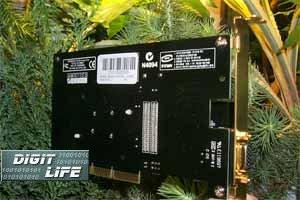
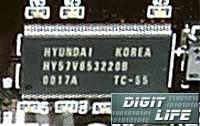 Hyundai produces memory modules with a 5.5ns access time which corresponds to 183 MHz. SUMA has released its new MX400 based card in full accordance with NVIDIA's recommendations as for the frequencies. The usage of 32 MBytes memory but of a very high quality gives an advantage to these cards. The card's design is identical to the SUMA Platinum GeForce2 MX PowerUP SIF; you can read about it in the summary review of SUMA's video cards. The difference lies only in the sticker "MX400". The cooler is nice and of quite an original design. SUMA is well known for the cooling devices installed in its video cards. 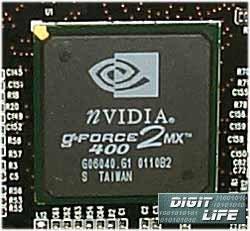 Under the cooler one can see the GPU GeForce2 MX400. I'll remind you that it differs from the popular GeForce2 MX only in the frequency, which is 200 MHz (instead of 175). An image passes through a SIF filter before it is displayed (this filter has already been described in our article). It is worth noting that:
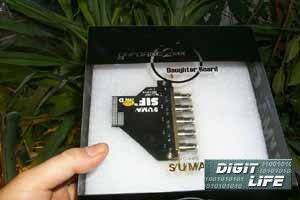  Moreover, today there are SIF daughter cards with BNC-outputs for connecting large monitors with special cables. But such cards are not very popular since a good BNC-to-BNC cable may cost three times more than the daughter card itself. Besides, SUMA is installing SIF only in the GeForce2 MX cards, and the owners of large monitors prefer other video cards. 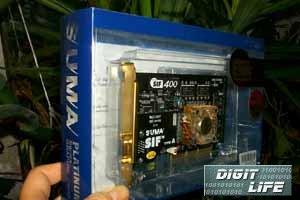 The card is shipped in a Retail-box of a traditional design (a transparent plastic box). The complete set includes:
OverclockingThe SUMA Platinum GeForce2 MX400 worked stably at the maximum of 240/210 MHz. The overclocking potential of the chip is impressive, but all of us know that for the cards of the GeForce2 MX class the memory bandwidth (and, therefore, its frequency) is a main bottleneck. Besides, you should note that the GPU initially works at 200 MHz, and not at 175 as for the usual GeForce2 MX cards. 2. SUMA Platinum GeForce2 MX PowerUp 5 nsThe SUMA Platinum GeForce2 MX PowerUp 5ns card has an AGP x2/x4 interface, 32 MBytes SDR SDRAM located in 4 chips on the face side of the PCB. 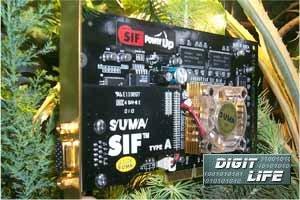 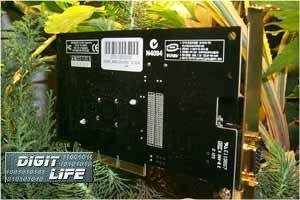 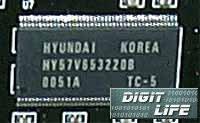 Hyundai produces memory modules with 5 ns access time which corresponds to 200 MHz. But the memory works at 183 MHz. In fact, this card doesn't differ from the usual SUMA Platinum GeForce2 MX PowerUp since the latter has a 5.5 ns access time memory which works at 183 MHz. All other parameters are the same as of the above card. 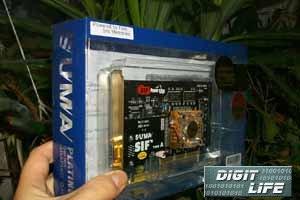 The card is shipped in a transparent plastic Retail-box box. The complete set includes:
OverclockingThe SUMA Platinum GeForce2 MX PowerUp 5ns worked stably at 220/220 MHz. The overclocking results would have been notable for a usual 166-MHz memory module but not for a 200-MHz one. 3. SUMA Platinum GeForce2 MX200The SUMA Platinum GeForce2 MX200 card has an AGP x2/x4 interface, 32 MBytes SDR SDRAM located in 4 chips on the face side of the PCB. There are two versions of this card: with a TV-out and without it. With a TV-out 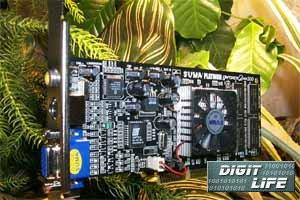 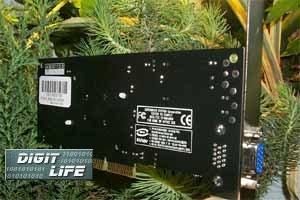 Without a TV-out   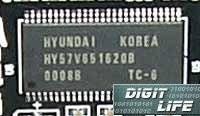 Hyundai produces memory modules with 6 ns access time which corresponds to 166 MHz. But with a 64-bit memory you should never expect the performance to be close to the GeForce2 MX. 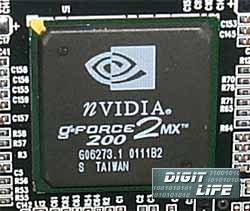 The card is equipped with the GPU GeForce2 MX200. Maybe it is a bit different in its production technology from a usual one, but it works at the same frequency of 175 MHz as the popular GeForce2 MX does. The card's design is completely based on the reference one from NVIDIA. The version with a TV-out has the corresponding connectors (RCA and S-Video) (by the way, it is a really rare case when there are two TV-out connectors, usually the card is equipped with S-Video only). 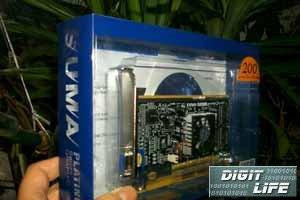 The Retail-box is transparent and plastic as well. Inside the box you can find:
OverclockingIs is impossible to increase the frequency of the SUMA Platinum GeForce2 MX200, that is why no overclocking has taken place here. With any change in frequencies, they were immediately set to default. Installation and DriversTest system configuration for testing the SUMA Platinum GeForce2 MX400:
For testing we used 11.01 drivers from NVIDIA. For comparison we have taken the results of the following cards: the Hercules Dynamite TNT2 Ultra (with frequencies decreased to the level of the Riva TNT2 - 125/150 MHz), Leadtek WinFast GeForce2 MX/DVI, Leadtek WinFast GeForce2 MX64, Leadtek WinFast GeForce2 MX MAX, SIGMA Cyber6000 (GeForce2 GTS). Test ResultsAs for the 2D graphics, it should be noted that the usage of SIF in the latest models of SUMA's video cards can cause worsening of the quality. But this is true not for all video cards and systems. Note that these cards may have problems with some mainboards: this causes unstable work, also some stripes may appear. Besides, the cards work correctly not with all monitors. The cards are implemented very good, and if the above-mentioned problems are absent, the 2D quality is perfect. One should note that the 2D quality greatly depends not only on a manufacturer but also on a definite sample. The following programs were used to estimate the 3D quality:
Quake3 Arenademo002The test was carried out in two modes: Fast (shows card's work at 16-bit color) and High Quality (shows card's work at 32-bit color). The SUMA Platinum GeForce2 MX200/MX400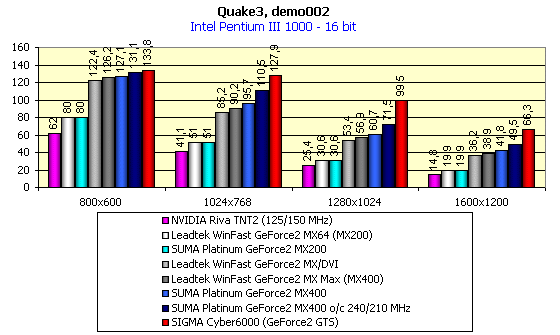 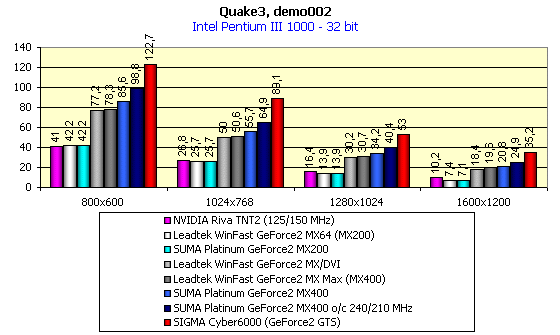 The SUMA Platinum GeForce2 MX 5ns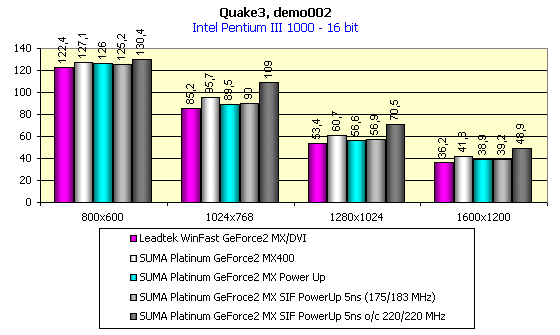 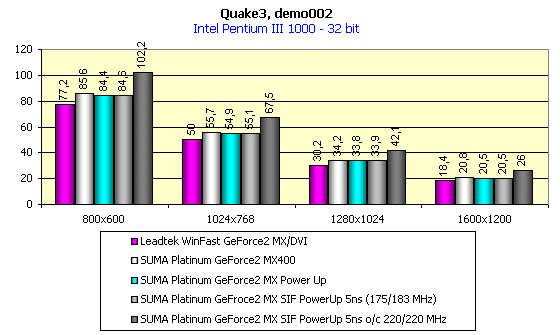 The results of the SUMA Platinum GeForce2 MX400 are not unexpected: at the expense of a faster chipset the performance at 16-bit color has increased as compared with a normal GeForce2 MX, and at 32-bit color an increased 183 MHz frequency allows the faster GPU to show its might. But even the overclocked SUMA Platinum GeForce2 MX400 falls terribly behind its elder brother - the GeForce2 GTS video card. The SUMA Platinum GeForce2 MX200 goes on a par with the Riva TNT2. It is not a surprise since this card was meant to replace the Riva TNT2 cards. Unfortunately, at 32-bit color this card is beaten even by the Riva TNT2. And even a higher memory frequency, as compared with an analog from Leadtek (166 MHz against 143), bears no fruit. The SUMA Platinum GeForce2 MX PowerUp 5 ns, when working at default frequency, doesn't differ from the usual SUMA Platinum GeForce2 MX PowerUp. But when overclocked it shows some positive results. ExpendableThe game is used to show the performance in Direct3D. The SUMA Platinum GeForce2 MX200/MX400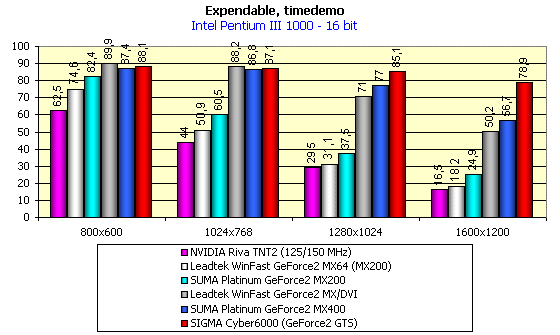 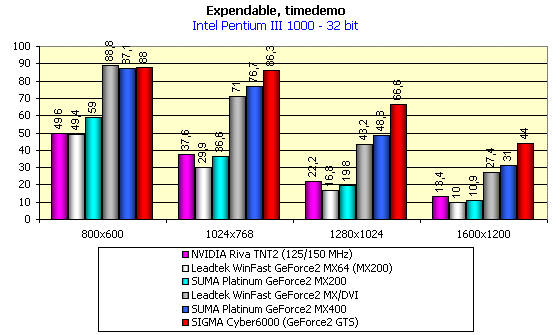 The SUMA Platinum GeForce2 MX 5ns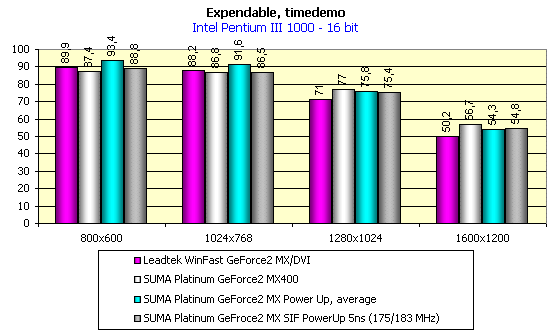 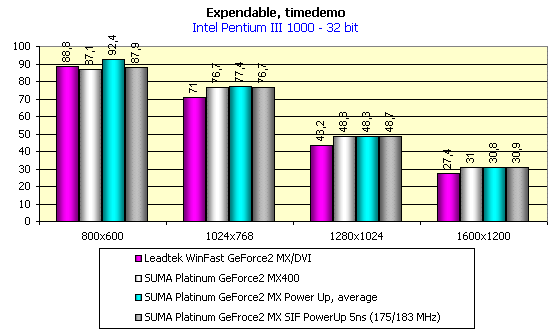 The situation is almost similar. The only difference is that at low resolutions the speed is limited not by the video card but the CPU frequency, video cards based on the GeForce2 MX (MX400) have caught up with the card on a more powerful GeForce2 GTS. Conclusion
Highs:
Lows:
Write a comment below. No registration needed!
|
Platform · Video · Multimedia · Mobile · Other || About us & Privacy policy · Twitter · Facebook Copyright © Byrds Research & Publishing, Ltd., 1997–2011. All rights reserved. |